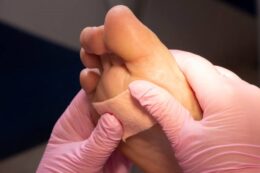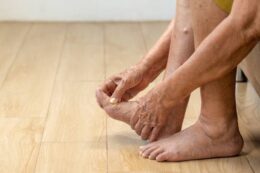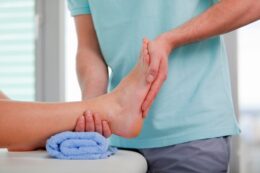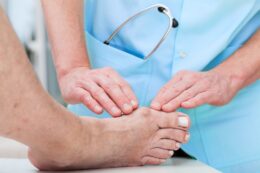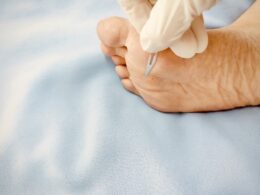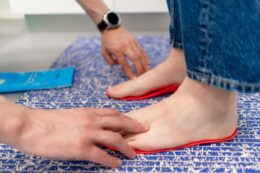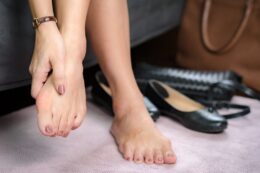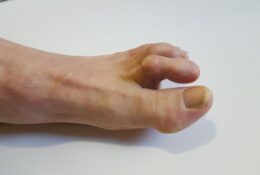Posted by AX.Admin …
From Callus to Comfort: Understanding Causes, Symptoms, and Treatment
A callus is a thickened, hardened area of skin that forms in response to constant pressure, friction, or strain. It acts as a protective barrier and commonly develops on the sides and soles of the feet. In this article, we will explore the different types of calluses, their causes, symptoms, and available treatment options.
Two General Types of Callus:
- Discrete nucleated callus: It is a localized and painful lesion with a central keratin plug. It sometimes gets confused with a plantar wart.
- Diffuse-shearing callus: A diffuse-shearing callus appears as a lesion larger than 1 centimeter without a keratin plug.
What Causes a Callus to Form?
A callus occurs due to a process called hyperkeratinization, the thickening of the outer layer of the skin, the stratum corneum, which is made of a protein called keratin. When there is constant pressure or friction on the skin, the body responds by producing extra layers of keratin to protect it.
Some factors that contribute to the callus formation:
Callus Symptoms:
When to Seek Medical Attention
Calluses can be managed with at-home treatments. However, individuals with chronic conditions like diabetes, peripheral arterial disease, or poor circulation, should seek medical attention from a podiatrist, dermatologist, or primary healthcare provider.
Callus Treatment Options:
- Conservative Treatment: This includes at-home remedies such as soaking the callus in warm water, filing the callus using a pumice stone, applying moisturizing cream daily, and using padding or proper footwear to protect the callus.
- Over-the-Counter Callus Treatments: While these treatments are available, individuals with medical conditions like diabetes should consult a podiatrist before using them, as they may contain harsh chemicals that can cause burns or foot ulcers.
- Cutting and Trimming: In more severe cases, a podiatrist can perform procedures such as callus reduction, which involves shaving away the thickened dead skin, or cortisone injections to reduce pain. However, surgery is rarely necessary and only considered when an underlying bone structure abnormality needs correction.
Preventive Measures:
Conclusion Calluses can be managed with proper care and treatment. By understanding their causes, symptoms, and available treatment options, you can take proactive steps to prevent them. If you have underlying medical conditions or severe symptoms, seek medical advice for appropriate care. For exceptional podiatric services, rely on Thomas Podiatry & Associates. Book an appointment with our experienced podiatrist today.
Most Common Aging-Associated Foot Problems and How to Manage Them
Just like the rest of our bodies, our feet also undergo a range of changes as we age gracefully. The aging process can bring about several health conditions that can impact our mobility and overall quality of life. You can take proactive steps to maintain healthy feet. Read on to learn more about the most common foot problems that accompany the golden years and the potential treatment options.
Arthritis
One of the prevalent foot problems among older adults is arthritis. It is a health problem that involves soreness and inflammation in the joints. This condition makes walking and performing daily activities challenging due to pain. Proper footwear, exercises, and medication can help manage this foot problem.
Plantar Fasciitis
It is caused by inflammation of the plantar fascia, a thick tissue band that supports the foot arch. This condition is often caused by repetitive strain and can result in heel pain and discomfort due to weakened tissue. Stretching exercises, orthotic inserts, and physical therapy can help relieve its symptoms.
Bunions
This condition refers to bony protrusions that develop at the base of the big toe. Bunions can be painful and cause difficulty in finding comfortable footwear. Aging can contribute to the development of bunions due to changes in foot structure and joint alignment. Wearing shoes with the right fit and using orthotic devices can help manage bunions and reduce discomfort.
Corns and Calluses
These refer to the thickened areas of skin that commonly develop on the feet. Corn and calluses often caused by pressure from ill-fitting shoes. Our skin gradually becomes thinner and loses its elasticity as we grow older. To prevent and treat corns and calluses, it’s important to exfoliate regularly, moisturize, and wear suitable footwear.
Peripheral Neuropathy
This condition refers to nerve damage that affects the peripheral nerves, leading to symptoms such as numbness, tingling, and burning sensations in the feet. Aging, along with conditions like diabetes, can increase the risk of developing peripheral neuropathy. Apart from maintaining good hygiene, individuals should seek medical attention whenever they experience any unusual sensations in their feet.
Conclusion
As we journey through life, our feet bear the brunt of it all. It is crucial to prioritize our foot health to ensure our mobility and overall health. Familiarizing ourselves with the foot problems that come with aging can help us take measures to prevent them and seek the necessary treatment if required. Aside from wearing proper and comfortable footwear, consulting with healthcare professionals can help ensure healthy and pain-free feet. Count on Thomas Podiatry & Associates for exceptional foot care, allowing you to enjoy your golden years with assurance. Contact us today to schedule a consultation with our podiatrist.
The Role of Physical Therapy in Treating Podiatric Injuries
Foot and ankle injuries can severely affect our daily lives, making even the simplest tasks challenging and painful. So, if you sustained a sprain, fracture, or dislocation, it’s crucial to get immediate medical care.
In addition to treatments like surgery, getting podiatric physical therapy is vital to regain the overall functions of the injured body parts. Here’s why this physical rehabilitation method is essential:
• Pain Management
Foot and ankle injuries often come with intense pain and discomfort. With physical therapy, you can better manage these symptoms and promote proper healing. Podiatrists employ pain management techniques, such as ultrasound, electrical stimulation, ice and heat therapy, and even manual methods, such as foot mobilization or therapeutic massages.
• Mobility and Strength Restoration
After an injury or a surgical treatment, your muscles and joints may become stiff and weak, hindering you from going about your usual daily routine. Physical therapy techniques can help regain the functionality and full range of motion of your injured foot and ankle.
When you consult a podiatrist, they will create a personalized exercise program that addresses your specific condition. Aside from increasing mobility and strength, thus promoting stability, these exercises will help prevent future injuries.
• Gait Analysis and Correction
Incorporating physical therapy in podiatric treatments also helps detect and fix potential gait problems after foot and ankle surgery. An abnormal walking pattern can affect your quality of life and even lead to further injuries, so they must be corrected. A physical therapist can perform gait analysis techniques to identify faulty walking patterns and provide ideal corrective strategies.
• Custom Orthotic Prescription
In some cases, foot and ankle injuries require custom orthotics or braces to aid rehabilitation. Since podiatrists specialize in foot care, they can determine whether you need additional support or alignment and prescribe the ideal devices accordingly.
Get Reliable Foot Care Services Near You
Podiatric physical therapy is essential in successfully healing foot and ankle injuries. If you sustain any, get in touch with a podiatrist for a personalized treatment plan, ensuring a quick and successful recovery. Contact Thomas Podiatry & Associates in Salisbury, MD for trusted foot care services.
5 Non-Surgical Bunion Treatments
Bunions are a common foot problem characterized by a bony bump on the joint outside of the big toe. This condition can cause significant discomfort and pain and affect foot function and stability, so prompt treatment is essential. There are several non-invasive bunion pain relief options available. Here are some of them:
• Medications
This is one of the simplest and most common treatments to reduce bunion pain and inflammation. While some non-steroidal anti-inflammatory drugs (NSAIDs) can be bought over the counter, it’s best to get a professional’s advice first to ensure they’re safe and suitable to your needs. Sometimes, pain relief topical creams may also be recommended.
• Physical Therapy
A skilled physical therapist can create a personalized treatment program to help you manage bunion pain. Besides manual care, they may also recommend exercises that enhance joint mobility, strengthen the muscles surrounding the affected area, and improve overall foot function.
• Footwear Modifications
Wearing proper footwear can significantly improve bunion symptoms. When choosing shoes, make sure they’re well-fitting, comfortable, and have the proper support based on your needs. You should also opt for footwear with a wide toe box to ease pressure on your bunions and prevent further irritation. If you are unsure of your shoe size or choice, consult a podiatrist.
• Orthotic Inserts
Another effective non-surgical bunion treatment is custom orthotics. These are designed to add arch support and redistribute pressure across the foot, relieving pain and preventing your condition from worsening. Orthotic inserts can be worn in various types of shoes, so you can manage bunion pain even when going about your daily activities.
• Bunion Splints
This orthotic device helps realign your big toe joint, reducing symptoms like pain and discomfort. Bunion splints are usually worn overnight or during periods of rest. With regular use, they can slow down the progression of your foot condition.
Contact Thomas Podiatry & Associates Today
Learning about non-surgical treatments for bunions is helpful in case you or a family member develops this foot condition. Get in touch with Thomas Podiatry & Associates for reliable podiatric services in Salisbury, MD. Our trusted podiatrists can help you with bunion pain relief and more!
The Importance of Regular Foot Check-Ups
Our feet allow us to stand, walk, and run, which is essential in our daily lives. So, getting injured or experiencing issues with them can significantly affect our mobility and way of living. That said, ensuring proper foot care is essential. One way to do this is through regular check-ups. Read on to learn how routine examinations can benefit your foot health.
• Early Detection of Foot Problems
Through routine exams, you can detect potential foot problems you may otherwise not know about without the help of a professional. Podiatrists or foot doctors can identify signs of existing conditions, such as corns, bunions, ingrown toenails, and Athlete’s foot.
Detecting foot conditions at their early stages allows you to get immediate care and treatment. Doing so prevents them from worsening and causing severe symptoms like burning pain or bleeding.
• Prevention and Maintenance
You don’t need an injury or condition to get a routine check-up. Since the podiatrist will assess your feet for any abnormalities in the skin, structure, gait, and more, they can evaluate their overall health.
With this information, your doctor can recommend ideal routines or treatments to maintain optimal foot health and prevent potential issues from occurring. This may include doing daily stretching exercises and using proper footwear or customized orthotics.
• Identify Related Health Conditions
Your foot health also impacts your overall well-being, as some medical disorders can manifest through symptoms in your lower extremities. Some of these may include swelling, numbness, or tingling sensations. With regular foot check-ups, you can identify early signs of conditions, such as diabetes, vascular diseases, or arthritis, and get the necessary treatment promptly.
Individuals who already have these medical conditions are also more vulnerable to foot problems. So, routine check-ups are crucial to prevent severe complications like ulcers or infections.
• Improved Overall Health
Your feet allow you to have mobility and stability and, as mentioned above, reflect your overall health. Through regular examinations, you can maintain optimal foot health and care for your well-being, thus improving your quality of life.
Consult a Trusted Foot Doctor
Now that you know the importance of regular foot check-ups, you can better prioritize scheduling them for you and your family. Reach out to us at Thomas Podiatry & Associates in Salisbury, MD for an examination or other podiatric services from our trusted podiatrist.
How To Determine if You Have Plantar Warts
Plantar warts are small skin growths typically found on the soles of the feet. These spots are caused by the human papillomavirus (HPV) when they enter through cuts or breaks in your skin. This foot condition may cause pain and discomfort, so it’s best to treat it immediately. To find out if you have plantar warts, here are some signs and symptoms to look out for:
• Appearance
You may recognize a plantar wart from its rough, fleshy, and grainy appearance. It may also have black dots or pinpoints on the surface, called wart seeds, which are dried blood vessels. Having thick, hardened, or callused spots on the bottom of your foot may also be a sign of a wart. To get the right diagnosis, you can always talk to a podiatrist.
• Location
Plantar warts often develop on the weight-bearing areas, such as the heel or ball of your feet, making standing or walking quite uncomfortable. Sometimes, warts may also appear on, around, or between your toes.
• Symptoms
Although some people don’t experience painful symptoms with plantar warts, others do. The pain is usually described as a sharp burning sensation, which can also be accompanied by tenderness. Because of this, standing, walking, and going about your daily routines can become difficult over time.
How Can You Treat Plantar Warts?
While plantar warts often go away on their own, it’s still best to have them removed immediately, especially if you have an autoimmune disease or a compromised immune system. Doing so also prevents the infection from worsening or spreading further.
Some common plantar wart treatments include over-the-counter medications, prescription topical creams, freezing, laser therapy, or even surgery. The type of procedure will depend on your overall condition. So, if you have developed a plantar wart, it’s best to consult a foot doctor for a proper diagnosis and a personalized treatment plan.
Get in Touch With a Trusted Podiatrist
Learning how to recognize plantar warts will help you get prompt treatment as necessary. If you suspect you have this foot condition, it’s best to see a podiatrist immediately. Contact Thomas Podiatry & Associates in Salisbury, MD for reliable podiatric services.
4 Benefits of Custom Orthotics
Custom orthotics, also known as shoe inserts, are medical devices made to match your feet’s precise structure, allowing maximum support and comfort. Besides helping manage symptoms of podiatric issues, like pain and misalignment, there are other benefits to using custom orthotics. Here are some of them:
Relieves Pain and Discomfort
Several foot and ankle conditions, including bunions, hammertoes, and plantar fasciitis, typically come with pain and discomfort. Since custom orthotics provide additional cushioning for the feet, using them when you experience certain podiatric issues will help ease painful symptoms.
Prevents Injuries
Some major causes of foot and ankle injuries include overuse and overexertion of the joints and muscles. These often occur when participating in various physical activities, like sports. So, aside from doing proper warm-up and stretching, using custom orthotics will prove helpful too. These shoe inserts help lessen the stress and pressure on your feet, reducing the risks of injuries like sprains or fractures during constant, harsh, and swift movements.
Provides Support
In addition to your foot’s structure, custom orthotics are designed to fit your body weight and gait, and correct misalignments. So, you can expect optimal support and improved balance and stability once you use them.
Aside from those with foot deformities like flat feet or high arches, people with obesity who need additional foot support greatly benefit from this medical device. These shoe inserts are also helpful if you need to stand or walk for long periods every day, especially if you’re wearing high heels.
Enhances Athletic Performance
Aside from treating existing foot and ankle problems, customized orthotics also help improve your overall performance during physical activities. Shoe inserts that are specifically designed for your condition and the type of activity you’re doing allow more efficient and precise movements without risks of injury.
Get Reliable Podiatric Services Near You
Learning about the benefits of using custom orthotics is helpful if you’re considering using them. If you have an existing foot and ankle problem or suspect you have one, consult a podiatrist for a checkup. Contact us at Thomas Podiatry & Associates in Salisbury, MD for more information about our services.
5 Tips To Prevent Bunion Pain
Bunions occur when excessive and continuous pressure on your feet forces your big toe to point toward the rest of your foot, causing misalignment. They are characterized by a bony bump that develops outside your big toe.
Aside from the pain and soreness, having bunions may also result in corns and calluses, further affecting your daily routines. That said, it’s best to learn how to prevent and alleviate bunion pain. Here’s what you should do:
- Wear Well-Fitting Shoes
One of the major risk factors for developing bunions is wearing tight, narrow, and pointy shoes. Because of the limited space ill-fitting footwear provides, they put excess pressure on your toes and mess with their proper alignment. If you already have a bunion, wearing these shoes will not only cause pain but also worsen your condition.
Because of this, it’s crucial to get footwear with the correct size. If possible, get a pair that has a roomy toe box, good arch support, and a comfortable fit.
- Use Padding or Shoe Inserts
Another way to prevent and reduce pain from bunions is by padding or adding orthotics to your shoes. Bunion pads provide additional cushioning to prevent your affected toe from rubbing against your shoes and causing discomfort. Meanwhile, custom shoe inserts help distribute pressure evenly on your feet, minimizing pain and the progression of your foot condition. To determine which works best for you, consult a podiatrist.
- Do Bunion Exercises
Exercising regularly helps improve your feet’s strength and mobility, thus relieving and preventing bunion symptoms like soreness and pain. Some exercises you can try are toe curls, toe stretches, towel crunches, and ball rolls. You can also talk to your foot doctor to ensure your routine is safe for your condition.
- Apply Ice to the Affected Area
This is one of the easiest ways to relieve painful, swollen bunions. If you notice these symptoms, especially after standing or walking all day, apply an ice pack on your feet for at least 10 minutes or more.
- Take Pain Medications
Of course, you can always take medication when you experience pain and inflammation with your bunions. A nonsteroidal anti-inflammatory medicine like ibuprofen can work wonders to reduce these symptoms. If necessary, your foot doctor may also prescribe a corticosteroid injection.
Contact Us at Thomas Podiatry & Associates
Learning about these tips will help ease any pain and discomfort associated with bunions. If you need a routine foot check-up or professional advice on your bunion pain, consult a podiatrist. Reach out to us at Thomas Podiatry & Associates in Salisbury, MD for reliable podiatric services.
How To Prepare Your Home Before Foot Surgery
When symptoms of conditions like plantar fasciitis, bunions, and Achilles tendon disorders aren’t alleviated with therapy or other initial treatments, foot and ankle surgery may be necessary. Since anesthetics are used, the procedure has minimal pain and discomfort. But you will need some time to recover fully.
As your mobility may be impaired after the surgery, preparing your home before the procedure is crucial. Here are some tips to help you with recovery:
Ask for Help in Advance
After a foot and ankle surgery, moving around on your own will be tough, making simple tasks like preparing meals and cleaning the house virtually impossible. So, as soon as the procedure is scheduled, reach out to a friend or family member who can help while you’re recovering at home. Doing so will also help you focus on caring for your feet and getting as much rest as possible to ensure a smooth recovery.
Create a Living Space on the Ground Floor
Using the stairs after foot surgery poses a safety risk. So, if your bedroom is on the second level of your home, utilize the living area or an extra room on the main floor instead. Take note that there should be enough space to move around comfortably and accommodate assistive devices you might use, like crutches or walkers.
Ensure your essentials are within reach in your new living space, so you won’t have to get up too often. These include your medicine, phone, laptop, tv remote, charger, and drinks and snacks. Besides that, hazards like uneven flooring or slippery rugs should be fixed and removed to prevent risks of tripping or slipping on them. Lastly, clear pathways from clutter and install proper lighting to avoid accidents.
Stock Up on Supplies and Necessities
Since it will be difficult to go out whenever you need to after the surgery, it’s best to stock up on all the necessities beforehand. Aside from the prescribed medication and other necessary tools for your recovery, ensure you have enough food, drinks, snacks, toiletries, and other essentials usually unavailable for delivery.
Consult a Trusted and Reliable Foot Doctor
Being prepared after a foot and ankle surgery is essential to ensure a smooth and fast recovery. If you experience persistent pain or other symptoms of your foot condition, consult a podiatrist to determine if you need surgical treatment. Contact Thomas Podiatry & Associates at Salisbury, MD for more information.
Hammertoes: Causes, Risk Factors, and Treatment
A hammertoe is a foot condition in which the toe is bent abnormally—pointing downwards instead of lying flat. It usually affects the second, third, or fourth toe and may be flexible and rigid. As its name suggests, a flexible hammertoe can still be moved, while a rigid one can’t.
Hammertoe pain is a common symptom of this foot condition, along with blisters, corns, and difficulty walking. Experiencing these can significantly impact your life, so it’s best to treat hammertoes immediately. Here’s what you need to know:
What Are the Causes and Risk Factors of Hammertoes?
A hammertoe develops when there is a muscle imbalance in your toes, causing them to form a downward shape. It can happen for various reasons, such as a traumatic toe injury. Other causes include:
- Wearing Certain Types of Shoes
High-heeled shoes can cause excess strain and pressure on your toes and joints, leading to hammertoes. Hence, women are more likely to develop this foot condition. Besides that, wearing narrow and ill-fitting shoes that crowd your toes also increases your risk of having a hammertoe. - Genetic Predisposition
Besides having a family history of hammertoes, the shape and structure of your feet from birth may contribute to developing this condition. Those with high arches, flat feet, and a longer second toe are likelier to develop a hammertoe. - Health Issues
Certain health conditions affecting the feet and ankles can increase the risk of developing hammertoes. These include arthritis, diabetes, stroke, polio, and spinal cord tumors.
How Are Hammertoes Treated?
There are various ways to ease and treat symptoms of hammertoe pain. Depending on the severity of your condition, some treatments may involve wearing custom orthotic shoes, stretching and exercising, and taping and splinting your toes. For more severe cases, your foot doctor may recommend surgery.
Get Reliable Foot Care and Treatment
Learning about hammertoes will help you determine whether you are at risk or have symptoms of this foot condition. If you experience hammertoe pain and want a foot checkup, consult a trusted podiatrist. Contact Thomas Podiatry & Associates in Salisbury, MD for more information.






